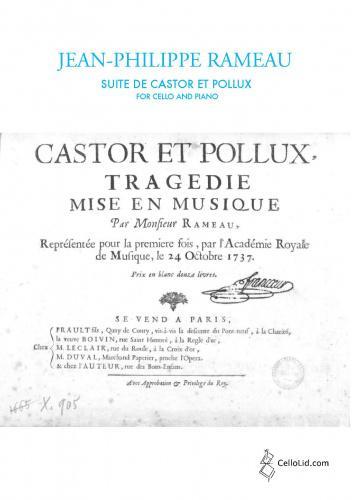Suite de Castor & Pollux
Description
Jean-Philippe Rameau's music is a portrait of his time. If the music of Bach is timeless, that of Rameau is precise: I can hear silk sweeping the floors of Louis XV's court, the acoustics of filled theatres. I can see daylight change to candlelight. His music is astonishingly imaginative, full of surprise and breath-taking variety. To that, add disarming charm and heart-breaking tenderness. Rameau is a composer of real invention and originality, of 'beauty that defies the caprices of fashion and commands the respect of true artists of all time'. (Grove's Dictionary 1928)
The first part of his artistic life, he spent as an organist and writer of music theory. In 1722 he published the ground-breaking Traité de l'harmonie, which laid the foundation for a philosophical science of harmony, placing the theory of music on a sound basis. In 1726, aged 43, he married 18-year old Marie Louise. Within the frame of a happy marriage, he wrote a string of successful operas. The last opera, Les Boréades, written in 1764 at the ripe age of 80, he never saw staged. 'If I were twenty years younger I would go to Italy and take Pergolesi as my model, abandon some of my harmony and devote myself to attaining the truth of declamation, which should be the sole guide of musicians'.
The reason for my transcription is to bring Rameau into the recital halls. Thus the beauty of his music will not only appear in the opera houses, but also share a sonata programme with other great composers, as Beethoven is shared with Schumann is shared with Brahms is shared with Debussy is shared with Scriabine is shared with Rachmaninoff.
I want to avoid overloading my piano score with the editor's dynamic suggestions like the baroque editions published around 1900. In the cello part I have given myself greater freedom, but those suggestions are as easily detected as dismissed, since Rameau only uses the words fort or doux. The sources used for this presentation are the first editions of the 1737 and 1754 versions, as well as Durand's publication from 1903 supervised by Camille Saint-Saëns and Auguste Chapuis. The Suite can be of any number and in any order. The present design and its alternatives below are, again, suggestions. Make a suite that is perfect for you.
Rameau's third opera, Castor et Pollux, a Tragédie en musique, was premiered on October 24th 1737. Its revival in 1754 brought some major changes, including the omission of the Prologue as well as cutting a substantial portion of the recitatives. He also added several instrumental movements.
- Winkel Antwerpen : 1 to 2 working days
